
The 5.56×45mm NATO is a rimless bottlenecked intermediate cartridge family developed in the late 1970s in Belgium by FN Herstal. It consists of the SS109, L110, and SS111 cartridges. On 28 October 1980, under STANAG 4172, it was standardized as the second standard service rifle cartridge for NATO forces as well as many non-NATO countries. Though they are not entirely identical, the 5.56×45mm NATO cartridge family was derived from and is dimensionally similar to the .223 Remington cartridge designed by Remington Arms in the early 1960s.

A cartridge or a round is a type of pre-assembled firearm ammunition packaging a projectile, a propellant substance and an ignition device (primer) within a metallic, paper, or plastic case that is precisely made to fit within the barrel chamber of a breechloading gun, for the practical purpose of convenient transportation and handling during shooting. Although in popular usage the term "bullet" is often informally used to refer to a complete cartridge, the correct usage only refers to the projectile.

A grenade launcher is a weapon that fires a specially designed, large-caliber projectile, often with an explosive, smoke, or gas warhead. Today, the term generally refers to a class of dedicated firearms firing unitary grenade cartridges. The most common type are man-portable, shoulder-fired weapons issued to individuals, although larger crew-served launchers are issued at higher levels of organization by military forces.
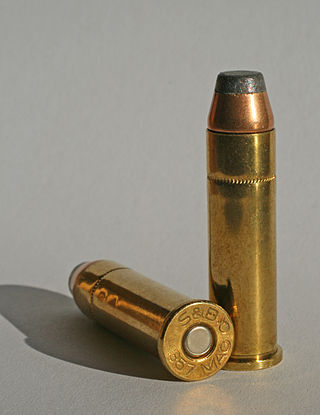
A centerfire cartridge is a firearm metallic cartridge whose primer is located at the center of the base of its casing. Unlike rimfire cartridges, the centerfire primer is typically a separate component seated into a recessed cavity in the case head and is replaceable by reloading.
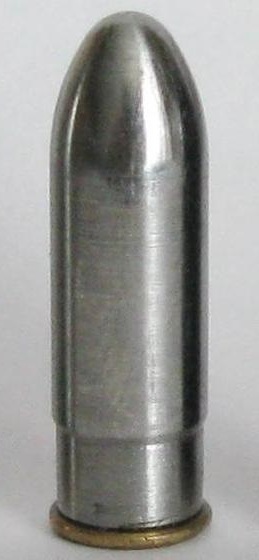
Caseless ammunition (CL), or rather caseless cartridge, is a configuration of weapon-cartridge that eliminates the cartridge case that typically holds the primer, propellant and projectile together as a unit. Instead, the propellant and primer are fitted to the projectile in another way so that a cartridge case is not needed, for example inside or outside the projectile depending on configuration.
A rifle grenade is a grenade that uses a rifle-based launcher to permit a longer effective range than would be possible if the grenade were thrown by hand.

A blank is a firearm cartridge that, when fired, does not shoot a projectile like a bullet or pellet, but generates a muzzle flash and an explosive sound like a normal gunshot would. Firearms may need to be modified to allow a blank to cycle the action, and the shooter experiences less recoil with a blank than with a live round. Blanks are often used in prop guns for shooting simulations that have no need for ballistic results, but still demand light and sound effects, such as in historical reenactments, special effects for theatre, movie and television productions, combat training, for signaling, and cowboy mounted shooting. Specialised blank cartridges are also used for their propellant force in fields as varied as construction, shooting sports, and fishing and general recreation.
The .30-06 Springfield cartridge, 7.62×63mm in metric notation, and called the .30 Gov't '06 by Winchester, was introduced to the United States Army in 1906 and later standardized; it remained in military use until the late 1970s. The ".30" refers to the caliber of the bullet in inches, .300 and the "06" refers to the year the cartridge was adopted, 1906. It replaced the .30-03, 6mm Lee Navy, and .30-40 Krag cartridges. The .30-06 remained the U.S. Army's primary rifle and machine gun cartridge for nearly 50 years before being replaced by the 7.62×51mm NATO and 5.56×45mm NATO, both of which remain in current U.S. and NATO service. It remains a very popular sporting round, with ammunition produced by all major manufacturers.

The .303 British or 7.7×56mmR, is a .303-inch (7.7 mm) calibre rimmed rifle cartridge. The .303 inch bore diameter is measured between rifling lands as is the common practice in Europe which follows the traditional black powder convention.

40 mm grenade is a generic class-name for grenade launcher ammunition in 40 mm (1.57 in) caliber. The generic name stems from the fact that several countries have developed or adopted grenade launchers in 40 mm caliber.
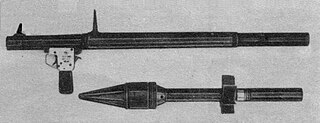
The RPG-2 is a man-portable, shoulder-fired anti-tank weapon that was designed in the Soviet Union. It was the first successful anti-tank weapon of its type, being a successor to the earlier and unsuccessful rocket-propelled grenade RPG-1.
This article explains terms used for the British Armed Forces' ordnance (weapons) and ammunition. The terms may have slightly different meanings in the military of other countries.

The United States Armed Forces has created a plethora of different types of 40 mm grenades in both the low-velocity 40×46 mm and high-velocity 40×53 mm calibers which uses what it calls a high-low propulsion system which keeps recoil forces within the boundaries of an infantry weapon. Presented on this page is a basic overview.
The following are terms related to firearms and ammunition topics.

Ammunition is the material fired, scattered, dropped, or detonated from any weapon or weapon system. Ammunition is both expendable weapons and the component parts of other weapons that create the effect on a target.
The .276 Enfield (7×60mm) was an experimental rebated rim bottlenecked centerfire military rifle cartridge developed in conjunction with the Pattern 1913 Enfield (P'13) rifle. Development was discontinued by the onset of World War I.
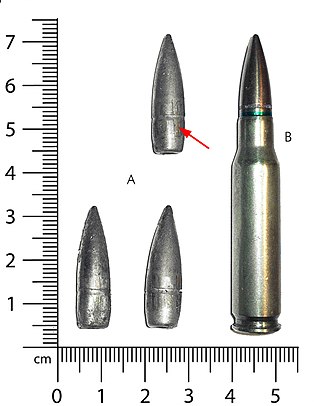
The 7.62×51mm NATO is a rimless, bottlenecked rifle cartridge. It is a standard for small arms among NATO countries.
In firearms and artillery, the primer is the chemical and/or device responsible for initiating the propellant combustion that will push the projectiles out of the gun barrel.
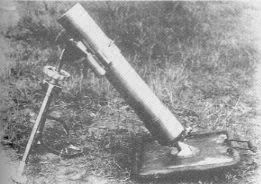
The Type 99 81 mm mortar was a Japanese mortar used by the Imperial Japanese Army during World War II. Its primary role was that of a lightweight mortar for airborne troops that could be quickly assembled or disassembled. The Type 99 designation was given to this mortar as it was accepted in the year 2599 of the Japanese calendar (1939). The Type 99 81 mm mortar is typical of the Stokes-Brandt type mortar. The Type 99 81 mm mortar differs from the Type 97 81 mm infantry mortar in the shortness of its tube and in the method of firing. The differences between the Type 99 and the US 81-mm mortar, M1 are pronounced.













